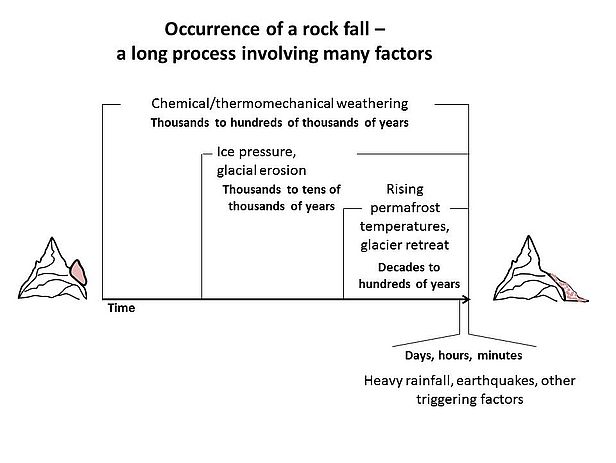11.09.2017 | News
The destabilisation of rock faces is the result of a long process that may last many thousands of years. A special 'dossier' article summarises the factors involved and the role of permafrost and global warming.
The destabilisation of rock faces is not a process that happens overnight but is instead the result of a long process that may last many thousands of years. Depending on the rock structure (e.g. fractures, stratification, hardness) and the topography, erosion processes act slower or faster. In high alpine regions, glaciers and permafrost also play a key role. Various factors may lead to fractures forming and opening up, increasingly destabilising the rock:
- Seasonal shifts in temperature;
- ice pressure in fractures (cryostatic pressure);
- glacial erosion;
- changing glacier levels;
- (heavy) rainfall (hydrostatic pressure, introduction of heat).
These factors have an impact over very different time periods. Over thousands of years, seasonal shifts in temperature weaken the rock. By contrast, heavy rainfall only becomes a decisive factor when there are already open crevices into which water can accumulate and thereby exert pressure on the rocks. Ice pressure in fractures plays a key role in high alpine regions. Such pressures occur when water from precipitation or pore spaces in the rock permeates into crevices and freezes there. The resulting ice wedges expand and fragment the rock.
During the ice ages, the glaciers formed steep mountainsides. When glaciers retreat, steep rock faces may be exposed and lose a crucial support.

The role of permafrost
Permafrost refers to soil or rock substrate with a temperature below 0°C for many years. In the Alps, permafrost in rock faces is found in areas above 2500 metres. On south-facing rock walls, permafrost is found above 3000 metres. In terms of rock fall, permafrost has two different roles:
- stabilising: the ice acts as a kind of glue holding fractured rock together.
- destabilising: permafrost supports the processes causing ice pressure in fractures. It draws water out of the warmer sections of rock and promotes the growth of ice wedges in crevices.
Therefore, permafrost may accelerate the fragmentation of rock faces yet at the same time stabilise these weak areas.
The role of global warming
Global warming accelerates various processes:
- The measurements made by the WSL Institute for Snow and Avalanche Research (SLF) and the Swiss Permafrost Monitoring Network (PERMOS) at various sites in the Swiss Alps show a rise in the temperature of the permafrost rock in many locations, more or less parallel to the increase in the air temperature. As the ice warms up, its stabilising effect declines. This falls abruptly at temperatures a few degrees below 0°C, potentially destabilising steep mountainsides and increasing rock fall in permafrost areas.
- Glaciers may give rock faces mechanical support. The melting of the ice as a result of global warming leads to this support being lost. Already brittle rock may sometimes collapse.
- Increased heavy rain in high alpine regions: A large amount of water infiltrating into the rock exerts substantial hydrostatic pressure, which may lead to fractures. In addition, the rain warms up the rock and causes the ice in the fractures to melt.

Contact ¶
Links and Documents ¶
Copyright ¶
WSL and SLF provide image and sound material free of charge for use in the context of press contributions in connection with this media release. The transfer of this material to image, sound and/or video databases and the sale of the material by third parties are not permitted.
